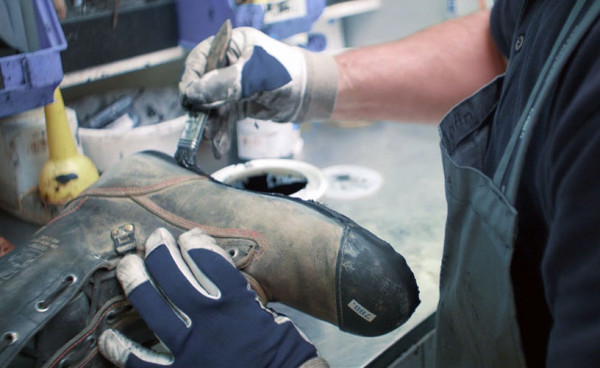We all have our favorite pair of HAIX work boots that fit just like a glove. They’re broken in and feel great, but there always comes a time when you need to look at either refurbishing them or give them the boot. HAIX does have an Extended Wear Program where you can refurb your boots once they are out of warranty, but there can be a point of no return for refurbishment too. So, what do you need to look for to decide whether to repair your work boots or just spring for a new pair?
First off, there are a lot of variables as to how quickly your boots can wear out such as the type of work you do, what type of job hazards you encounter, how often you wear the boots, even your size and weight can factor in. Regular inspection of your boots is especially important when you are wearing safety protective boots because you don’t want to risk your safety, leading to injury.
- Cuts, tears, punctures, burns or worn thread
- Check eyelets, laces, and straps for tearing, ripping or fraying
- Check the inner liner for tears, holes or excessive wear
- Check for loss of water resistance
- Check for loss of seam integrity and broken or missing stitches
- Check for an exposed, dented, or deformed toe cap in safety toe boots
- Check sole tread for tread loss or sole separation
- Check the function of zippers, if applicable
Once you inspect your boots, you can have a better idea what the next step should be if you notice any issues. If you notice only minor wear and tear, the HAIX Extended Wear program may be an option and can offer either a refurbish package or just a retread of the sole. Most HAIX boots, though not all, qualify for this program*. Click here to get all the details on the HAIX Extended Wear Program.
When looking to refurbish your HAIX work boots, there are some items that will not be eligible for repair or retread, and you would need to look at retiring them. When considering a boot retread, bear in mind there is a point of no return for a retread, similar to when you should replace your car’s tires. If the tread gets too low, and definitely if it is to the point of no tread at all, then it will not qualify for a retread, and it is time for that new pair boots. Low tread can lead to slips and falls. In addition, boots that have sole separation, delamination or cracks cannot be repaired or retreaded, and should be retired.
Most seam separation or broken stitches can be repaired, as long as there are no resulting tears in the leather, and can be sent for refurbishment through the Extended Wear program. Missing eyelets, hooks, or broken zippers can also be replaced.
If boots have damage to a toe cap, especially after a heavy impact, it cannot be repaired and should be replaced. A damaged toe cap could lead to injury if another heavy impact occurs. As for the outer rubber toe cap, in most cases, we can replace the outer rubber toe cap as long as it has not worn down to the steel or composite of the toe cap.
A compromised inner liner also cannot be repaired. If you have leakage, and you are exposed to damp conditions or hazardous chemicals, then boots should definitely be replaced. The same goes for any signs of cuts or punctures that compromise the inner liner as this greatly reduces its protective function. Remember your boots might be the only thing between you and hazardous conditions.
Do not forget that routine cleaning and polishing of your boots can extend their life. But no matter how much you love your HAIX duty boots, all good things must come to an end. Whether it’s a result of normal wear and tear of many years, or it got damaged during wear, you should always look to replace you boots to ensure your feet stay happy and healthy. Invest in your feet, you will be glad you did.
*Older, discontinued Black Eagle models and Vibram sole boots cannot be retreaded.


